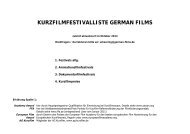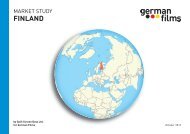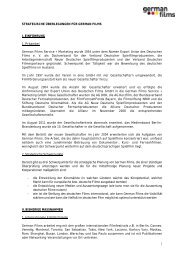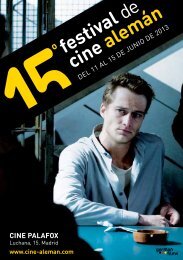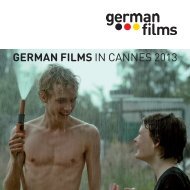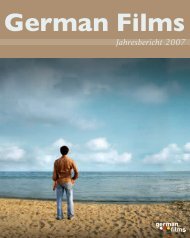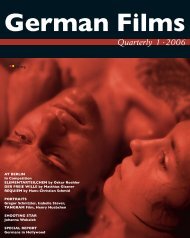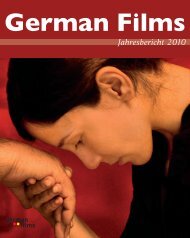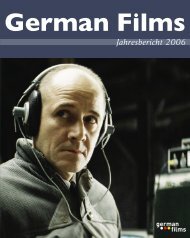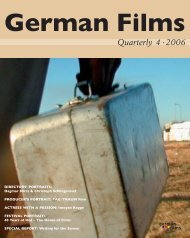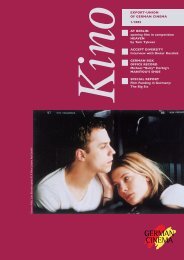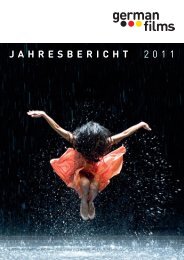Titel Kino 2/2001(2 Alternativ) - German Films
Titel Kino 2/2001(2 Alternativ) - German Films
Titel Kino 2/2001(2 Alternativ) - German Films
Create successful ePaper yourself
Turn your PDF publications into a flip-book with our unique Google optimized e-Paper software.
FILM ARCHIVES AND FILM MUSEUMS IN THE FEDERAL REPUBLIC<br />
The Film Museum Düsseldorf, opened in 1993, developed<br />
from the nucleus of community film work. Its exhibition documents<br />
the collecting activities begun by the city of Düsseldorf<br />
at the end of the seventies. By contrast to Frankfurt, where the<br />
first part of the permanent exhibition offers a clearly subdivided,<br />
didactic tour on the history of perception in film, the makers<br />
in Düsseldorf have brought together the experience and the<br />
history of film in a style resembling a mosaic, distributed throughout<br />
various rooms on three floors; here it is possible to find the<br />
fan cult, a look back to shadow theater, and alongside this, a<br />
presentation of the technical collection.<br />
The fourth and most recent film museum in the Federal Republic,<br />
the Film Museum Berlin, established in the Sony Center at<br />
Potsdamer Platz, has had a varied history. During the eighties<br />
there were already plans to present the collection of the SDK in<br />
a museum to be housed in the former Hotel ”Esplanade“ beside<br />
the Potsdamer Platz, which was not built on at all at that time.<br />
However, the fall of the Wall and tugs of war over new<br />
construction work on Potsdamer Platz meant that the planned<br />
museum was put on ice, and its official opening was not possible<br />
until September 2000. Its permanent exhibition follows the thread<br />
Expressionist Studio Exhibit/<strong>German</strong> Film Museum Frankfurt (photo © <strong>German</strong> Film Museum)<br />
of Berlin film history; beginning with a gallery of shimmering film<br />
images, it presents the pioneers and the early divas of <strong>German</strong><br />
film, concentrates on the classics of silent film in <strong>German</strong>y, and<br />
also focuses on the years between 1933 and 1945, which meant<br />
collaboration for some and exile for others. The exhibition<br />
”Artificial Worlds“ on the history of special effects completes<br />
the tour.<br />
Collections<br />
The archives and museums with their different emphases guarantee<br />
diversity in collection, although <strong>German</strong> film dominates, of<br />
course. But this widely scattered archive scene also compensates<br />
for a deficit in post-war film history in the Federal Republic: there<br />
is no central film library. Ultimately, plans for this failed because of<br />
the Republic’s federal structure, which gives each state cultural<br />
10<br />
sovereignty. It was not until 1978 that the regulations of the<br />
Association of <strong>German</strong> Film Archives were developed<br />
to take over the tasks of a central film library. The three large<br />
archives are full members of this association, whilst the film<br />
museums of Frankfurt, Munich, Potsdam and Düsseldorf are also<br />
co-opted members.<br />
There is no legal deposit in the Federal Republic – no duty to<br />
deposit current film material as there is in some other European<br />
countries. The Federal Archive in Koblenz concerned itself<br />
primarily with the collection of documentary films. Not until<br />
1974 was the policy of collecting complementary copies of all<br />
films sponsored by the Federation introduced at the largest<br />
<strong>German</strong> archive, now holding around 150,000 titles. Nonetheless,<br />
the Federal Film Archive, which must limit itself to<br />
<strong>German</strong> productions, is dependent on acquisitions or donations<br />
in order to complete its collection. It also offers producers a<br />
contractually regulated deposit – long-term surrender – of the<br />
negative of a film.<br />
Within this system, the small archives in particular offer a<br />
guarantee that the marginal fields of film are also collected:<br />
independently produced<br />
films, advertising films,<br />
experimental films which<br />
often work using exotic<br />
formats such as Super 8<br />
and often only exist<br />
as unique copies. The<br />
Film Museum Munich<br />
(without exhibitions, but<br />
with a community cinema)<br />
has a large collection<br />
of films by <strong>German</strong>-author<br />
filmmakers dating from the<br />
sixties until today available<br />
in its archives.<br />
The lending conditions and<br />
prices of archives differ; but<br />
non-commercial users such<br />
as educational institutions or<br />
community cinemas are<br />
usually given reductions.<br />
Initial information may be<br />
found on the websites of<br />
<strong>German</strong> archives and<br />
museums (cf. address list<br />
p. 14), where there are<br />
usually also lists of people<br />
to contact and their e-mail<br />
addresses. Versions of<br />
<strong>German</strong> films with subtitles<br />
are only available in very<br />
limited numbers in the archives. Subtitled versions in English,<br />
French and Spanish, for example, usually in 16 mm format, are<br />
offered by the Goethe Institute Inter Nationes, which is<br />
responsible for the presentation of <strong>German</strong> culture abroad.<br />
For information about the collection, the people to approach<br />
are those at the individual Goethe Institutes.<br />
All the archives are making constant efforts to extend and to<br />
complete their collections. The widest range of collected objects<br />
is surely to be found at the four film museums in Berlin, Düsseldorf,<br />
Frankfurt and Potsdam. These do not only collect film<br />
copies, but also technical exhibits, photos, film programs, screenplays,<br />
production documents, posters and press pull-outs.<br />
Amongst the most fascinating collected objects in the museums<br />
are designs for costumes and scenery, for in a certain way, these<br />
anticipate the images of a film. The largest collection of this kind<br />
is probably owned by the SDK with works including those of



